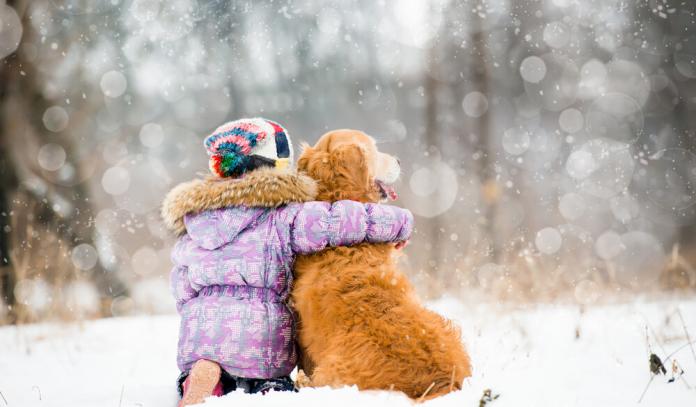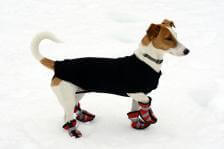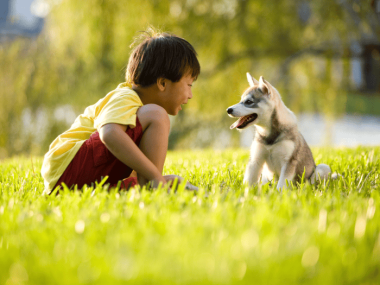Hypothermia and Frostbite: Winter Weather Dangers for Your Dog
Just like people, animals can get hypothermia and frostbite in the cold. Veterinary specialist Vanessa Yeager explains how to recognize the signs and prevent your dog from a deadly situation this winter.

Winter can be one of Mother Nature’s most deadly seasons. Temperatures can become dangerously cold, putting individuals at risk of developing hypothermia and frostbite. According to the Centers for Disease Control and Prevention, approximately 1,300 people die each year from exposure to the cold.
Similarly, a large number of animals are also seen in the ER each winter experiencing the detrimental effects of the cold. That’s why it’s crucial to keep our canine companions safe and warm this winter.
Can Dogs Get Hypothermia?
To begin, let’s talk about hypothermia – what it is and how it becomes deadly.
Hypothermia is defined as 2o Celsius below normal body temperature. For humans this would mean having a temperature of about 96o F or 36o C. For dogs, a temperature of about 98o F or 38o C would indicate hypothermia since dogs have slightly higher normal body temperatures than we do. And their temperature can drop well below 98o F depending on the circumstances.
How cold it is outside, how they are exposed, and how long they have been exposed all contribute to the severity of hypothermia. Spending an hour outside on a sunny 320 F day may make them a little chilly – nothing a warm sleep by the fire wont fix. But that scenario is not as life threatening as spending just 10 minutes in a freezing cold lake after falling through the ice in a failed attempt to catch a squirrel.
See also: Chilly Dogs: Caring for Your Dog in Cold Weather
Immersion in water or having damp fur from sleet or wet snow can cause rapid hypothermia as water draws out body heat quicker than air alone. Those of you who have taken the “polar plunge” at some point in your life can surely relate. Being cold is one thing – being cold and wet is quite another. So in essence, the colder the temperature, the shorter amount of time it takes to become hypothermic, especially if you’re wet.
And just because dogs have a fur coat does not make them any more immune to the cold. Their fur coats work in the same way the winter jackets we begrudgingly sport each winter do – they help insulate heat generated from the body, keeping us toasty for some period of time. But after a while outside in freezing temperatures, we start to get cold and our dogs do, too.
So how can you spot hypothermia symptoms in your dog?…
How to Spot Hypothermia Signs in Your Dog?

This mechanism increases the risk for developing frostbite (which I’ll discuss in more detail later on). Signs of early hypothermia include:
- shivering
- rapid breathing
- increase in urination
- cold ears and feet
- hair standing on ends (this is known as piloerection, or goosebumps for dogs
At this point, bring your dog indoors and if they are wet, dry them off with a warm towel, and offer fresh lukewarm water. As hypothermia progresses, breathing will become slow and shallow, the dog may seem lethargic or disoriented. One key sign of the late stage of hypothermia is the absence of shivering despite being cold to the touch. If you suspect your dog (or any dog for that matter) is very cold but not shivering and seems disoriented, please take them to your local veterinarian immediately. They will need immediate care.
Feeling chilly? I am!
Can Dogs Get Frostbite?
The second weather-related injury your dog can develop this winter is frostbite. As I mentioned earlier, frostbite occurs when blood flow is restricted in areas furthest from the body’s core. This is the body’s way of trying to keep blood warm around the central vital organs.
Areas such as the ears, nose, tail, paws, legs, and genitals are typically affected by frostbite. Have you run out to get those little booties for your dog yet? If you don’t spend a lot of time outdoors during the winter with your dog, your dog may not need them. According to a December 2011 article in the Journal of Veterinary Dermatology, researchers discovered that dogs are able to conserve heat fairly well in their densely vascularized, fat-padded paws allowing them to cope with winter tundra a lot better than we can with our bare feet.
However wonderful paw pads are in conserving heat, they are not completely resistant to the cold. If subjected to freezing temperatures for a prolonged period of time, paw pads can become frostbitten. Signs of frostbite are:
- discoloration (often the paw pads will be pale, red, blue, or black)
- painful or cold to the touch
- swelling
- pain upon warming the area
If you suspect your dog has frostbite, slowly warm the area with warm water. Do not use direct heat such as a hair dryer or heating pad and do not rub the area as this can cause further tissue damage. If the area is black or will not warm up despite your efforts, please take the dog to your local veterinarian as soon as possible.
I always say prevention is the best medicine. When it comes to preventing hypothermia and frostbite in your pet this winter, my best advice is to keep your canine out of the cold for extended periods of time, and avoid ice and bodies of water (frozen or not).
If you are traveling outdoors with your dog this winter (hunting or taking long hikes in the snow), purchasing those little booties might not be a bad idea. Small breed dogs, puppies, geriatric dogs, dogs with hypothydroism or heart disease, and those that usually spend their days indoors curled up in a soft blanket are at an increased risk of developing hypothermia.
If you dream of having outdoor adventures with your dog this winter, take him on short walks or for brief playtime outside then gradually increase the length of the activity to help their body acclimate to the chilly weather.
Have a great week and be sure to give your four-legged friend a big hug for me.
Vanessa Yeager holds a Masters in public health and will graduate from the University of Illinois as a doctor in veterinary medicine in May 2015. She has worked in a variety of veterinary practices, with both small and large animals. Through her experiences she has found a passion for health communication in the veterinary field as well as educating owners on animal health and wellness.
Images of dog and girl and dog in sweater courtesy of Shutterstock.
Please note: This content is strictly for informational purposes only. It does not replace advice or judgment by a your local veterinarian. See a licensed veterinarian in your area for all veterinary related issues.







